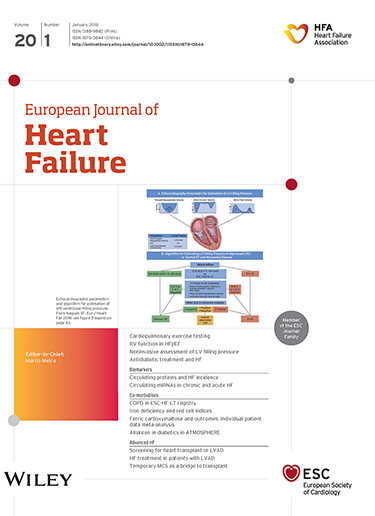急性心力衰竭护理——国际专家组共识系列。
IF 10.8
1区 医学
Q1 CARDIAC & CARDIOVASCULAR SYSTEMS
引用次数: 0
摘要
从20世纪60年代初到几年前,急性心力衰竭(AHF)住院患者的护理基本上没有变化,主要包括氧气和利尿剂,有时辅以其他血管活性药物。这些治疗虽然在短期内有效控制充血,但不能防止早期再入院和死亡,30%以上的患者在AHF住院后6个月内发生再入院和死亡。近年来的研究表明,AHF的诊断可以提高,早期利尿护理可以优化,早期联合用药强化治疗可以降低不良反应发生率。然而,与急性冠脉综合征不同的是,急性冠脉综合征的指南自1996年以来就存在,AHF没有单独的详细指南。在一系列四篇论文(AHF管理国际专家意见系列)中,一个国际专家组强调了AHF护理的重要方面,这些方面缺乏为临床实践提供信息的证据基础。这些论文集中于(1)院前和急诊科的诊断和治疗,(2)入院第一天的管理,(3)AHF出院前后的护理,以及(4)心源性休克、严重瓣膜疾病或终末期肾脏疾病患者的住院AHF管理。这些论文并不打算作为指南,而是为AHF的诊断和治疗提出一个框架建议。在当前的总结论文中,我们强调了AHF护理的每个部分的主要考虑因素和关键建议。本文章由计算机程序翻译,如有差异,请以英文原文为准。
Acute heart failure care - a consensus series of an international experts' group.
The care of patients hospitalized for acute heart failure (AHF) has been largely unchanged from the early 1960s until a few years ago, consisting mainly of oxygen and diuretics supplemented sometimes by other vasoactive drugs. These treatments, although effective in the short term in controlling congestion, do not prevent early readmissions and death, occurring in over 30% of patients in the 6 months after an AHF hospitalization. In the last years, studies showed that AHF diagnosis can be improved, early diuretic care can be optimized, and early intensive therapy with combined drug regimens can reduce the rate of adverse outcomes. However, unlike acute coronary syndromes, where guidelines have existed since 1996, there are no separate detailed guidelines for AHF. In a series of four papers (International Expert Opinion Series on AHF Management) an international expert group highlights important aspects of AHF care where the evidence base to inform clinical practice is lacking. These papers focus on (1) diagnosis and treatment during prehospital and in the emergency department, (2) management during the first days of admission, (3) care before and after AHF discharge, and (4) hospitalized AHF management in patients presenting with cardiogenic shock, significant valvular disease, or end-stage renal disease. These papers are not intended to serve as guidelines, but rather to suggest a framework for future recommendations for the diagnosis and treatment of AHF. In the current summary paper, we highlight the main considerations and key recommendations in each of the parts of AHF care.
求助全文
通过发布文献求助,成功后即可免费获取论文全文。
去求助
来源期刊

European Journal of Heart Failure
医学-心血管系统
CiteScore
27.30
自引率
11.50%
发文量
365
审稿时长
1 months
期刊介绍:
European Journal of Heart Failure is an international journal dedicated to advancing knowledge in the field of heart failure management. The journal publishes reviews and editorials aimed at improving understanding, prevention, investigation, and treatment of heart failure. It covers various disciplines such as molecular and cellular biology, pathology, physiology, electrophysiology, pharmacology, clinical sciences, social sciences, and population sciences. The journal welcomes submissions of manuscripts on basic, clinical, and population sciences, as well as original contributions on nursing, care of the elderly, primary care, health economics, and other related specialist fields. It is published monthly and has a readership that includes cardiologists, emergency room physicians, intensivists, internists, general physicians, cardiac nurses, diabetologists, epidemiologists, basic scientists focusing on cardiovascular research, and those working in rehabilitation. The journal is abstracted and indexed in various databases such as Academic Search, Embase, MEDLINE/PubMed, and Science Citation Index.
 求助内容:
求助内容: 应助结果提醒方式:
应助结果提醒方式:


